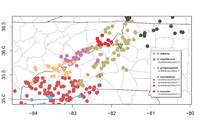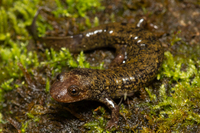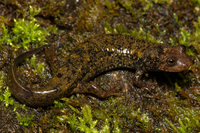Taxonomy
Class: AmphibiaOrder: CaudataFamily: PlethodontidaeSubfamily: Plethodontinae
Taxonomic Comments: Species Comments:
Identification
Description: Desmognathus folkertsi resembles a miniature version of our other Black-Bellied Salamander species. It is a moderately large member of the genus, with adult males ranging in size from 58–85 mm SVL and adult females from 56–76 mm SVL. A large series of adult males from the type locality varied from 58-81 mm SVL and averaged 71 and 73 mm for two yearly samples (Camp and Marshall 2006). Adult females were smaller on average (65 and 67 mm between years), and varied from 56-75 mm SVL. D. amphileucus using molecular markers, as well as body size, coloration, and body proportions (Camp 2004). Where the two occur in sympatry, adult female SVL does not overlap (56–76 mm in D. folkertsi ; 81–102 mm in D. amphileucus and overlap in adult male SVL is slight (58–85 mm and 79–120 mm in D. folkertsi and D. amphileucus , respectively). In the range of overlapping sizes for preserved males, young adult D. amphileucus can be distinguished from old adult D. folkertsi by having single-lobed testes, whereas the latter have at least three lobes per testis. Newly metamorphosed individuals of both species have white venters that darken with age. Newly metamorphosed D. folkertsi have SVLs < 40 mm, whereas those of D. amphileucus range from 44–56 mm SVL. Fully black-ventered D. folkertsi may be as small as 40 mm SVL. In contrast, no sympatric D. amphileucus have completely black venters until they reach at least 60 mm SVL. D. amphileucus have a dorsal red stripe on the tail for several years following metamorphosis that often persists in subadults. The red disappears from the tails of D. folkertsi within a few weeks after metamorphosis. Immature D. amphileucus also often have an olive-green dorsum, which is never evident in D. folkertsi . Finally, most D. amphileucus do not have a dorsal pattern of defined brown blotches, while many D. folkertsi do.Online Photos: Google iNaturalist AmphibiaWeb Account
Distribution in North Carolina
Distribution Comments: The geographic range of D. folkertsi is incompletely known, but it appears to be a narrow endemic that is restricted to north-central Georgia and to nearby Clay Co., North Carolina (see distribution map above). This species was first documented in North Carolina in 2007 (Rothermel et al. 2007), and at least nine local populations have are documented within the county since then. Populations occur in Union, Towns, and Lumpkin Cos., Georgia at elevations from 670-1035 m (Camp 2004, Camp and Tilley 2005).Distribution Reference: Camp 2004; Camp and Tilley, 2005County Map: Clicking on a county returns the records for the species in that county.
GBIF Global Distribution
Key Habitat Requirements
Habitat: This species is primarily aquatic or semiaquatic and can be found in high gradient, rocky streams similar to those preferred by D. amphileucus (Camp and Tilley 2005).Biotic Relationships: Desmognathus folkertsi often occurs microsympatrically with other congenerics, including the Seepage Salamander (D. aeneus ), the Ocoee Salamander (D. ocoee ), the Seal Salamander (D. monticola ), and the Nantahala Black-bellied Salamander (D. amphileucus ). Desmognathus folkertsi is similar in size to D. monticola but is more aquatic and occupies habitats similar to those of . Despite the potential for interspecific competition between these species, ecological interactions are poorly documented. Gut analyses of syntopic D. amphileucus provided no evidence of predation on Desmognathus folkertsi (Camp 1997, Camp and Tilley 2005).
Life History and Autecology
Reproductive Mode: Camp and Marshall (2006) believed that the females oviposit during May or June based on the seasonal progression in the sizes of developing ova. Clutch size was positively correlated with female SVL, and varied from 23–62 ova (average = 38 and 41 eggs for two yearly samples). Pierson (2012) found two nesting females in Georgia on 22 July with eggs in early developmental stages. The yellowish-white eggs were attached in a monolayer to the undersides of small, flat rocks in a first-order stream. Both nests were guarded by females, and one contained 29 eggs. When examined on 28 August the embryos had hatched and the females were no longer present. Aquatic Life History: The larvae often coexists with those of D. amphileucus and are not readily distinguishable from the latter. As such, many aspects of the larval diet and ecology are largely undocumented. Camp et al. (2002) estimate the larval period to last around two years based on larval size classes, with metamorphosis occurring primarily in July-September (Camp and Marshall 2006). Terrestrial Life History: The juveniles and adults reside under cover objects and in leaf packs within streams or along stream margins. The juveniles often wander at night, but the adults tend to remain in refugia at night with only their heads or the anterior parts of their bodies exposed where they ambush passing prey (Camp and Tilley 2005). The diet is poorly documented, but adult water bugs (Hemiptera) and crane-fly larvae are known prey (Camp and Tilley 2005). The juveniles appear to require two years to reach sexual maturity (Camp and Marshall 2006). Females require about 16 months for their ova to fully develop, which suggests that they either breed biennially or irregularly, with one or more years skipped before ovipositing again.
General Ecology
Adverse Environmental Impacts
Status in North Carolina
NHP State Rank: S1Global Rank: G2G3Status in North Carolina: SC

 »
»



 »
»

